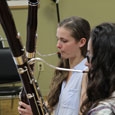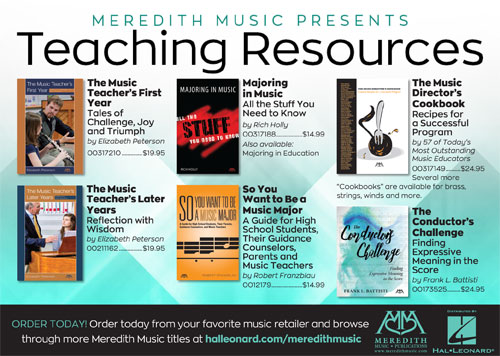During the spring, thoughts turn to solo and ensemble contests. In the earliest months of the year, students are assigned pieces and form chamber groups. They work hard and learn much from this endeavor, but after the contest is over, the ensemble often disintegrates from lack of time, leaving students without chamber music until the cycle begins again the next year. While most recognize the value of students performing in chamber groups, busy directors must focus on the most pressing matter – the spring concert, summer activities, and the marching season as fall approaches. Starting a duet club is an ideal way to keep chamber music going all year and reaping the benefits such ensembles provide.
Time
The first barrier to keeping chamber ensembles running year-round is time. Especially in those programs with only one director, there is often too much to accomplish during the day. However, some creative strategies can lead to a happy outcome for all involved.
In many programs, students gravitate to the band hall toward the beginning or close of the school day; this should be when the chamber club meets. For this fifteen minutes or half hour, students practice, and directors often aid with music or administer playing exams. This time can also be used for student chamber ensembles, especially for smaller groups, like duos and trios. Different parts of the band room can be requisitioned daily for each ensemble.
Literature
Collections for like instruments or, even better, collections for flexible instrumentations, can be a wonderful first step. From there, larger ensembles can be built over time.
Age and Ability
Most students should be able to start playing in a small chamber group after a year and a half on their instruments, if not less. What is necessary for success, especially if the director is not needed for everyday rehearsal, is a good, characteristic sound, some level of technical confidence and independence, and the ability to count and keep a constant pulse. Playing tests in the first year of instruction can help with all of this.
Placement
Pairings should not need constant oversight. The goal is to foster more chamber music. Ideally students will be inclined to play with each other, rather than spend all of their time talking. As every director knows, putting best friends together can often be a bad idea.
Do not be afraid to pick students from different sections to perform with each other in a duo. As stated before, many excellent duet collections now exist at various levels for mixed instrumentation. The only limit is balance. A saxophonist and trumpet player will make an excellent duo, while a young flutist paired with a brass player may result in some overblowing on the part of the flutist. Director common sense and judgment will never lead one astray in this regard. When pairing students, just consider those factors as well as ability level (not necessarily grade level), and all will be well.
Getting Started
When starting a duet club, especially with younger students, the first few meetings will need to be more hands on for the director. Take a few minutes each day and demonstrate the basics of working together as an ensemble. This is a perfect way to introduce advanced concepts, including adjusting pitch while playing and keeping time without a conductor. It is not necessary for the band director to rehearse these groups constantly. Time must be spent in the beginning stages, but after a couple weeks, the director can float between ensembles, offering help just as with students working out individual parts.
Students should already be familiar with tuning in a larger ensemble or class context before starting chamber music. The issue of waves is important for any discussion of intonation, so if the students have been taught how to properly tune a reference note, the chamber ensemble can provide the ideal platform for discussing tuning in context on the fly.
There is no need to be too verbose or technical in teaching how to introduce adjusting intonation: Make sure players know how to adjust pitch on their instrument while playing. Once some success has been achieved, pick a duet with longer note values in each part. Have two student volunteers perform it, hitting and holding each interval, listening for waves. Tell the performer on the upper part to bend the pitch up and down until the waves go away. Of course, there may be intonation problems in the lower voice, but having students alternating parts between the top and bottom voices using this method will help both members of the duo start to learn pitch discrimination and adjustment without overly confusing the situation.
Practicing Independence
Keeping time may be difficult for young performers playing without a conductor for the first time. Programs that advocate foot tapping and counting will have far more success with part independence. Each student in a duet should be instructed to tap their feet in unison while playing together. In addition, students should count each part together, and then count their own parts at the same time. While these skills must have been taught previously, their emphasis here will greatly increase the independence and confidence of young musicians.
Once these skills have been taught, the duets can be performed with minimal input from the director. Of course, it is always a wonderful motivator to provide some sort of performance, such as a night of holiday-themed chamber music in December or a spring progressive concert.
Expanding the Program
A chamber music club based on duets can work well on any level. There are many like-instrument and mixed duets that can be quite challenging, and the honing of intonation discrimination and musical independence know no bounds. However, duets can also lay the groundwork for a wider chamber program.
Starting with duets allows students to step into a standard chamber ensemble with much more comfort and ease. All of the performance skills necessary for a saxophone quartet, brass quintet, or small percussion ensemble are mirrored in duet playing. Perhaps a bit of help from the director will be necessary in the beginning to aid in applying these concepts, but the students will start working as a unit with minimal input and help.
A vibrant duet program can help the age-old problem of conscientious directors: there is a desire to engage all students in chamber playing, but most traditional ensembles, because of their makeup, will leave some students out in the cold. Duets (and perhaps trios) can fill the void when students are in between other ensembles or when the literature available in other groups does not allow them to perform. For student development, it is far better for a young musician to be the only person on a part in a duo than it is to perform doubled up on a part in a larger group.
While brass and woodwind quintets are standard, well-established groups, a wise director will consider less commonly seen ensembles, including clarinet quartets and brass trios, to ensure that as many students as possible can be involved. When in doubt, an enterprising director can transcribe a high-quality public domain work. Other directors may very well be looking for good literature for the same instrumentation, and publishers are always in search of great new pedagogical chamber pieces.
A duet club can be a great way to introduce students to a form of music making that they can enjoy many years after their time in school music programs is complete. In addition, it builds vital performance skills, provides low brass and other sometimes neglected students with technical challenges, and can keep marching band auxiliary performers on their instruments during the fall. It is great fun to make music with a friend.








